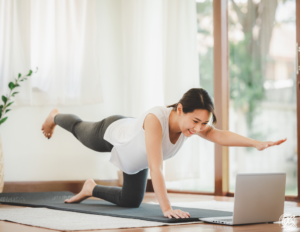
Maintaining a balanced movement routine is key to achieving and sustaining overall health and wellness. Incorporating cardio, strength training, and flexibility exercises ensures that your body stays strong, mobile, and resilient. Here’s how to design a well-rounded exercise regimen that caters to all aspects of physical fitness.
Why Balance Matters
A balanced movement routine isn’t just about variety for variety’s sake—each type of exercise contributes uniquely to your health:
- Cardio improves cardiovascular health, enhances body composition, and enhances endurance.
- Strength training builds muscle, boosts metabolism, and supports bone health.
- Flexibility exercises enhance range of motion, prevent injury, and aid recovery.
Combining these elements creates a comprehensive fitness plan that supports your overall well-being, helping you to move better, feel stronger, and live a healthier life.
1. Cardio: Elevate Your Heart Rate
Cardiovascular exercise is crucial for heart health and endurance. It includes activities that get your heart rate up, such as:
- Running or jogging
- Cycling
- Swimming
- Dancing
- Brisk walking
Guidelines: Aim for at least 150 minutes of moderate-intensity cardio each week. This can be spread across several days—think 30 minutes, five times a week. For a more intense workout, try high-intensity interval training (HIIT), which alternates short bursts of high-intensity effort with recovery periods.
2. Strength Training: Build Muscle and Bone Health
Strength training isn’t just about building muscle—it’s essential for bone health, joint stability, and metabolic function. Effective strength workouts include:
- Bodyweight exercises like squats, push-ups, and lunges
- Weight Lifting using dumbbells, kettlebells, or resistance bands
- Functional movements such as deadlifts and kettlebell swings
Guidelines: Incorporate strength training exercises 2-3 times a week. Focus on working all major muscle groups: legs, back, chest, arms, and core. Ensure you allow at least 48 hours of recovery between strength sessions for the same muscle group to prevent injury and optimize gains.
3. Flexibility: Stretch and Lengthen
Flexibility exercises are often overlooked, but they are crucial for maintaining joint health, reducing muscle tension, and preventing injuries. Key flexibility exercises include:
- Static stretching after workouts
- Yoga for both flexibility and strength
- Dynamic stretching before workouts to prepare your body for movement
- Pilates for core strength and flexibility
Guidelines: Dedicate time to flexibility exercises after every workout. Spend 10-15 minutes stretching the major muscle groups. On rest days, consider engaging in a full yoga session to deeply stretch and relax your body.
Putting It All Together: Your Weekly Routine
To create a balanced movement routine, distribute these exercises throughout your week (this is only one example):
- Monday: 30 minutes cardio + 20 minutes strength training (upper body)
- Tuesday: 30 minutes cardio + 15 minutes flexibility (yoga or stretching)
- Wednesday: 20 minutes strength training (lower body) + 15 minutes flexibility
- Thursday: 30 minutes cardio + 20 minutes strength training (core)
- Friday: 30 minutes cardio + 15 minutes flexibility
- Saturday: Full-body strength training + 10 minutes flexibility
- Sunday: Rest or light activity like walking or yoga
Tips for Success
- Listen to Your Body: Adjust your routine based on how you feel. It’s okay to modify intensity or duration, especially if you’re new to exercise or recovering from an injury.
- Progress Gradually: Start with what feels manageable and gradually increase the intensity, duration, and frequency of your workouts.
- Stay Consistent: Consistency is key to seeing and feeling results. Even short, regular workouts are better than sporadic intense sessions.
- Mix It Up: Keep your routine engaging by varying your activities. This helps prevent boredom and ensures you’re challenging different muscle groups.
Conclusion
A well-rounded movement routine that balances cardio, strength, and flexibility is essential for optimal health. By integrating these elements into your weekly schedule, you’ll build a strong, resilient body that’s capable of handling the demands of daily life—and you’ll feel great doing it.
Whether you’re a seasoned athlete or just beginning your fitness journey, this balanced approach will help you achieve your goals while supporting long-term health and wellness. Start small, stay consistent, and remember that every movement brings you one step closer to Living Life Well!





